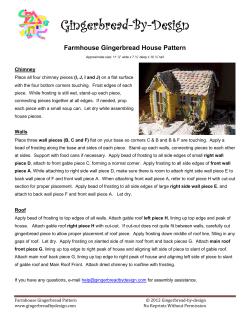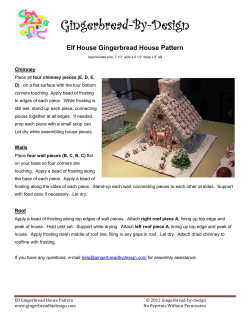
Cedar Roof Care & Maintenance Cedar Shake & Shingle Bureau
Cedar Roof
Care &
Maintenance
R
R
Contact us for further details:
Cedar Shake & Shingle Bureau
US Address
PO Box 1178
Sumas, WA 98295-1178
Canadian Address
#2-7101 Horne Street
Mission, BC V2V 7A2
TEL: 604-820-7700
FAX: 604-820-0266
info@cedarbureau.com
www.cedarbureau.org
Printed in Canada Feb. 2011
Certi-label™ cedar is naturally long-lasting
Cedar shakes and shingles have been used for hundreds of
years. They have proven their longevity in actual weather
conditions, in all types of climates. Cedar shakes and shingles
contain oils that make them naturally decay resistant. High
humidity areas can get added protection with Certi-Last®
pressure-impregnated preservative treated material. Cedar's
insulative quality, aesthetic appeal, and wind and impact
resistance make Certi-label cedar shakes and shingles the
natural choice for your roofing and siding material.
Longevity starts with a quality manufacturer
Not all cedar products are alike. Purchasing cedar products
with the "Certi" brand name on the bundle label guarantees
you that the mill undergoes inspections by an independent
third party inspection agency. Only Cedar Shake & Shingle
Bureau ("CSSB") member mills are allowed to label their
products with the Certi-label. Each member mill's bundles will
have the distinctive Certi-label tucked under the bundle strap.
Locating Certi-label products is as close as your nearest
computer or telephone. Contact the CSSB for more
information.
Longevity continues with a
quality installation
Roof construction plays a major role in determining the
lifespan of cedar roofs. Proper design is absolutely critical to
ensure long-term roof integrity. Proper installation will help
maximize the life of cedar products. CSSB Approved Installers
have met membership criteria and continue to prove
themselves with each job they complete. Approved Installers
offer a workmanship guarantee, references, and are the only
contractors authorized to give homeowners the Member
Manufacturer’s Lifetime Limited Warranty administered by the
CSSB. Locating Approved Installers is as close as your nearest
computer or telephone. Contact the CSSB for the names of
members in your area.
Experienced care and maintenance
professionals can make recommendations
based on:
• Zinc or copper strips nailed at the ridge cap and on the field
of the roof can be effective to control moss and algae. The
optional use of these strips can be eliminated by using
Certi-Last® preservative treated products.
• Overhanging branches should be kept trimmed away from
the roof. This will prevent leaves, small branches and other
debris from building up and keeping the roof wet.
• Gutters and downspouts need to be cleaned regularly,
usually in the spring and fall. Downspouts (leaders) should
run directly to the ground or to another gutter below.
Never let a downspout drain directly onto a lower roof
surface.
• Cedar needs to breathe, and therefore needs to be kept
clean. Do not allow leaves, branches or other debris to
build up on the roof. Both surface areas and keyways
(spaces between shakes and shingles) need to be kept
clear.
• Ensure ventilation is available, year round. Areas with
louvers, ridge vents, roof vents, and soffit vents need to be
kept clear and never blocked off. Adequate ventilation
ensures that heat and moisture do not build up in the attic
area. Adequate ventilation also prevents water from
accumulating at the bottom of the roof and then freezing
(ice damming).
Certi-label™ cedar is also available
with a pressure-impregnated
treatment process
For even longer life span, where climate is a factor, CSSB
members offer Certi-Last® pressure-impregnated preservative
treated shakes and shingles. These products are ideal for areas
of high humidity. The CSSB recommends using Certi-Last®
products in the following areas: Alabama, Delaware, Florida,
Georgia, Hawaii, Kentucky, Louisiana, Maryland, Mississippi,
North Carolina, South
Carolina, Texas (in the counties of: Angelina, Austin, Brazos,
Chambers, Fort Bend, Galveston, Grimes, Hardin, Harris, Jasper,
Jefferson, Liberty, Montgomery, Newton, Orange, Polk, Sabine,
San Augustine, San Jacinto, Trinity, Tyler, Walker, Waller, and
Washington), Virginia and West Virginia. Read the Member
Manufacturer’s Lifetime Limited Warranty administered by the
CSSB for more details.
Certi-Last® products are cedar shakes and shingles that are
factory pressure-treated by quality treaters who are members of
the CSSB. Contact the treatment company for warranty details.
Pressure-impregnated treated Certi-Last® (preservative) or
Certi-Guard® (fire-retardant) products should not receive after
market roof treatments without written permission from the
manufacturer of such products.
A word about topical treatments
for installed roofs
There are hundreds of companies offering topical roof spraying
and cleaning services. The CSSB has conducted an in-depth
study of care and maintenance systems, and provides the
following summary:
• Avoid the fly-by-night operation that has no permanent
office, no workmanship guarantee, and no local references.
Fly-by-night operations often gouge consumers for
thousands of dollars beyond the value of their service,
leaving them with damaged roofs covered with unsuitable
and sometimes dangerous treatment products.
If you elect to have a topical treatment applied to your cedar
roof, the CSSB recommends the following:
• Is a water repellent, UV inhibitor, and/or EPA registered
wood preservative.
• Check references including consumer, Better Business
Bureau and Chamber of Commerce.
• Has a manufacturer's performance guarantee.
• Ask about the treatment product that is being used.
DO NOT use a topical treatment product that:
• Ask to see the company's workmanship guarantee, license
and workers' compensation coverage.
• Makes outrageous claims (such as a 10-year effectiveness).
• Ask to view roofs that the company has treated, both
recently and a few years prior.
Topical treatment products
It is not within the CSSB's mandate to recommend brand
names of topical roof treatment products. The CSSB does,
however, recommend the following:
• Makes fire-retardant claims.
• Is a sealant, waterproofer or plasticizer.
• Contains unfortified linseed oil, diesel fuel or crank case oil.
The CSSB is aware of numerous bleaching and cleaning
agents. Many claim to be effective on moss/mildew removal or
accelerating cedar's change to the weathered gray color.
Consumers are advised to heed the preceding topical
treatment precautions before allowing such products to be
applied to a cedar roof.
DO use a topical treatment product that:
• Offers a MSDS (Material Safety Data Sheet that lists
product ingredients and safety precautions).
• Is labeled as a cedar roof treatment product or has a letter
from the manufacturer stating that treating cedar roofs is an
appropriate use of this product.
Powerwashing
This is the most controversial issue in the care and
maintenance industry. It is a fact that high pressure washing by
inexperienced people will cause significant damage to any
material. Some debris can easily be removed with garden hose
pressure. Some contractors powerwash to clean roofs, while
others do not. If powerwashing is used, the roof should receive
a topical treatment to restore the roof. The CSSB recommends
having a professional assess each job on an individual basis. A
professional should consider the following factors to determine
if powerwashing is appropriate or not:
Repair overview
The following diagrams give an overview of correct repair tools
and methods.
Tools to repair cedar shake or shingle roofs
1. Slater’s Ripper
• Age, condition and environment of roof
• for pulling and cutting nails under shakes or shingles
• Gallons sprayed per minute
• use as pry bar
• Fan tip size
2. Hack Saw Blade Saw
• Distance spray nozzle is held from roof
• for cutting nails under shakes or shingles
• Pressure per inch and others…
3. Pry Bar
• for prying up shakes or shingles
The beauty of cedar
Another good thing about cedar is that it is possible to replace
and repair parts of the roof, without worrying that the
replacement shakes or shingles are significantly different in
composition from the original shakes or shingles. Over the
hundreds of years that cedar has been used, the product has
remained unchanged…it's still cedar. As cedar advances to its
mature stage, it is natural to expect some pieces to require
replacement. Individual repairs are possible, and with prompt
attention, proactive repairs can extend the life of your wise
Certi-label cedar investment.
• for pulling nails out from
under shakes or shingles
using nail hole in bar
1.
2.
3.
Repairing a cedar shake or shingle with a
metal shim inserted under the defect
The dark corrosion resistant metal shim should be about
2 1/2" wide and be about 1/2" longer than the weather
exposure of the product it
is to repair. The bottom
two corners should be
Dark metal shim for
sealing/repairing under
shake or shingle defects
angle to keep the shim
from sliding out of repair.
The shim should be slid all
the way under the course
Bottom
corners
bent down
45° to
hook roof
2 1/2"
width
length
exposure + 1/2”
bent down at a 45 degree
to be repaired and out of
sight. If well done, this type
of repair should last as long as the roof.
Removing a damaged cedar shake or shingle
from an existing roof
Pry up the shake to be removed and the shakes directly above
the shake to be removed so that the nail shafts and heads can
be accessed under the shakes. Pull out or cut nails using hack
saw blade saw, pry bar or slater's ripper.
Use hooks on the side of slater's ripper or hole in the pry bar
to hook nail heads under the shakes to pull the nails. The
shake can then be pulled and wiggled out of the roof.
Replacing a missing shake in the roof field,
ensuring that the nails are not exposed
Slide a shake fitted to the empty area into the empty area.
Hold the shake 1/2" below the final fitting position. Install two
of the proper nails at a 45 degree angle at the butt of the
covering course. Drive the shake up the last 1/2", covering the
nail heads, using a wood block against the shake butt to
reduce splitting.
© Copyright 2025


















